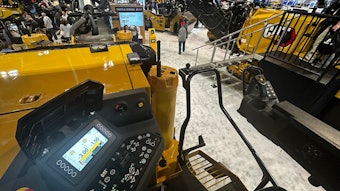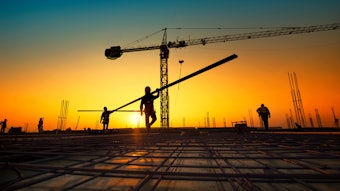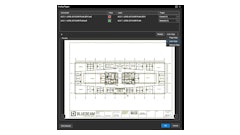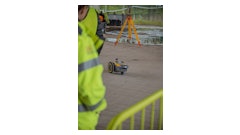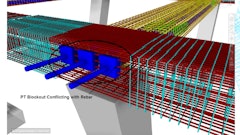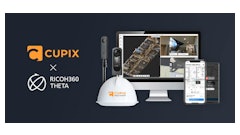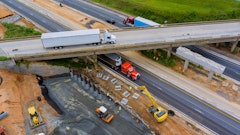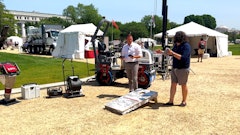
Construction professionals constantly feel the challenge of time pressure on the modern jobsite, and hard-to-use or complex tools and working conditions may only combine to make the environment feel intimidating.
Contractors face many challenges today on the jobsite; just consider data from The Civil Quarterly (TCQ) from Dodge Construction Network, produced in partnership with Infotech and Hexagon. Broadly speaking, it reveals uncertainty, including concerns over the unending labor shortages and increased regulations.
Coupled with the rising cost of materials, contractors are right to approach their daily routines with some level of consternation. Compounding the challenge for surveyors and concrete contractors is the often-daunting task of laying out intricate designs with complex geometries. Unfortunately, staked points are often reduced to lines and rectangles and, as a result, will not accurately depict the true design once brought to the field.
To compensate for these many challenges and potential headwinds, concrete contractors need to eliminate errors and accidents, which can be financially costly, potentially causing lost time or, worse, the loss of life. Luckily, concrete contractors have a proverbial technological ace in the hole: robotic total stations.
What are robotic total stations?
These electronic and optical instruments, often mounted on a tripod, speed up the construction and installation processes, enabling users to lay out more points accurately and eliminating the potential for costly rework. They can also help monitor projects when securely collecting data is imperative and real-time decision-making is mission-critical.
There are two types of total stations: manual (mechanical) and automated (robotic). Both operate using the same principle of measuring horizontal and vertical angles and the distance to an object.
While surveyors can perform all tasks with either manual or automated total stations, the robotic option offers a key advantage: productivity.
Robotic total stations combine an electronic theodolite and electronic distance measurement, measuring vertical and horizontal angles and the distance from the device to a specific point, such as a hanger or anchor location.
These tools generally offer a reliable, simple, automatic setup process and are considered robotic — or perhaps more specifically automated — because they allow a single operator to remotely manage the tool, while a manual station requires two people to operate. Its easy-to-use interface, accuracy and quickness in layout applications make it ideal for engineering and construction professionals, particularly those working on large-scale projects.
Considering the difficulty many companies have hiring skilled labor, a tool like total stations requiring only one operator can enable teams to accomplish more with fewer team members.
Robotic total stations are more than just a tool. They seamlessly integrate into construction workflows, drastically reducing the time needed for installation preparation and construction tasks.
Users can work more efficiently by increasing the points laid out daily with minimal interruptions — even on the most congested sites with distractions ranging from reflections to machines to people moving around. Advanced stations allow users to easily manage interruptions through an automatic prism re-lock feature, which uses cutting-edge technology to ensure a quick and accurate layout.
These devices have an additional practical use in monitoring complex structures such as buildings or dams, detecting movement, and warning of potential structural collapse.
Total stations are still evolving
Robotic total stations are generally less expensive than other solutions, such as 3D laser scanners. Additionally, given the number of options on the marketplace, potential users can opt to start with a more basic offering, learn how to incorporate the solution into their organization and its processes and grow what tools they use as business demands dictate.
Even though robotic total stations have transformed how concrete teams bring digital designs to life on the jobsite, they are still evolving. New solutions, such as tilt-compensated total station poles, further boost productivity through tilt compensation, automatic pole height readings, and unique target identification. Tilt compensation decreases the time needed to measure while increasing flexibility and safety by enabling team members to measure points in inaccessible locations or ones that might put the user at risk.
The new generation of manual total stations is often equipped with timesaving and efficiency-enhancing features, like smart keypads and a one-button auto instrument height reading.
Additionally, self-learning total stations adapt automatically to site conditions, whether rain, fog, dust, sun, reflections, or heat shimmer, eliminating the need to adjust the station should the conditions change.
Eliminate the guesswork
Contractors can offset delays with unparalleled visibility into every aspect of the project and real-time data to make informed decisions, ensure profitability, and prevent costly overruns. Building the perfect data-driven jobsite starts before the first shovels are turned and continues until the final nails are driven. It then extends throughout the life of an asset in the form of building intelligence, helping with ongoing and predictive maintenance.
Robotic total stations play a hugely important role in this process, as users can easily and confidently lay out lines for footings or chalk lines for formwork on a foundation. Before pouring concrete, they can also lay points on the blinding layer, like pipe inserts or cut-outs.
The stations use design data for accurate layouts, from 2D CAD to object-based BIM models. It also enables MEP layout of hanger locations for HVAC, wall penetrations for pipes, and sheet metal work, including duct work, inserts, and slits.
As-built and verification tasks can be completed directly on the site. Additionally, users can control construction machines, including dozers, graders, milling machines, and asphalt and concrete pavers.
The modern jobsite
For several reasons, the construction industry has sometimes been slow to adopt technology, relying on the “way things have always been done” which usually entails paper-based processes.
However, when considering it, the jobsite has been a source for evolution and transformation. The modern jobsite is an incredible intersection of tradition and technology, and it is built on data.
Just as concrete mixes have evolved and continue to evolve, so will the tools concrete contractors use to perform their jobs. Today, in addition to their tampers and trowels, teams need accurate information to make informed decisions and keep projects on time and within budget.
The concept isn’t necessarily new; it’s just that the speed at which the jobsite moves continues to increase. Additionally, with the arrival of new and younger workers, the resistance to technology is expected to decrease.
Although some companies have been reluctant to embrace new technology, many already use robots, machinery, and equipment. The first step toward building the modern, technology-enabled jobsite is accepting how new solutions can revolutionize the approach to the jobsite — and make it safer in the process.
The modern jobsite is filled with challenges, whether the skilled worker shortage or increasing costs. However, elevating the use of technology doesn’t have to be one of the concerns facing businesses; instead, it should give them the confidence to approach problems that have plagued them for far too long.
Solutions that empower contractors to eliminate mistakes, save time, and accomplish more with fewer resources aren’t “a nice to have” anymore, they’re an absolute necessity.
